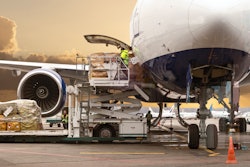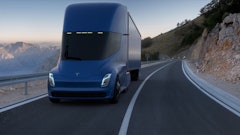
The cold chain transportation industry continues to experience a shift. A growing market fused with a move toward electrification is expected to keep the industry innovating. From telematics to traceability and everything in between, new technologies and software solutions are in position to keep temperature-controlled products moving through the cold chain safely and efficiently.
But the nature of unpredictability continues to plague the cold chain industry, presenting a host of challenges and even setbacks.
That’s why a host of new solutions and technologies are pertinent in keeping the cold chain market moving forward.
Current market outlook
The North America cold chain market size is expected to reach $333.96 billion by 2030, registering a CAGR of 17.1% from 2023-2030, according to ResearchAndMarkets.
Spot truckload rates, for example, rose in June despite declines in the number of loads moved, according to research collected by DAT Freight & Analytics.
“The month ended strong for dry van freight, with nearly 25% more volume moving during the final week of June compared to last year,” says Ken Adamo, DAT chief of analytics.
The 2024 State of Logistics Report, produced for the Council of Supply Chain Management Professionals (CSCMP) by Kearney and presented by Penske Logistics, shows that U.S. supply chains pressured by global economic volatility, including inflation, climate change and geopolitical conflicts, are enhancing their capabilities to accelerate resilience, agility and flexibility to navigate current and future disruption.
Data from Truckstop and FTR Transportation Intelligence for the week ended Aug. 30 shows sharp increases in broker-posted spot rates for refrigerated van and dry van equipment during the week before Labor Day. Dry van spot rates were not as strong in relation to historical performance but rose by the most week-over-week since International Roadcheck week in May. However, flatbed spot rates were down for an eleventh straight week to their lowest level since July 2020. The increase in total load postings was the first in five weeks. Coupled with a sizable drop in truck postings, the Market Demand Index increased to 57.4, which is the highest level in four weeks.
 The current state of freight markets empowers shippers to wield pricing power.Pexels
The current state of freight markets empowers shippers to wield pricing power.Pexels
On the other hand, the latest release of the TD Cowen/AFS Freight Index from AFS Logistics and TD Cowen shows the uneven effects of continued demand and capacity imbalances playing out across multiple transportation modes. While less-than-truckload (LTL) carriers are holding the line with pricing discipline, parcel rates are showing the effects of aggressive discounting and excess truckload capacity continues to suppress a pricing recovery.
“The current state of freight markets empowers shippers to wield pricing power and re-evaluate how to best make use of logistics networks,” says Tom Nightingale, CEO of AFS. “Carriers, on the other hand, continue to step up the sophistication and nuanced defenses of their revenue streams, with subtle and frequent ancillary price increases.”
Although there have been a couple of negative readings for FTR's Shippers Conditions Index, it's been mostly positive, Avery Vise, VP of trucking for FTR Transportation Intelligence, detailed in Food Logistics’ SCN Summit: State of the Supply Chain webinar.
“The negative readings have been primarily due to brief surges and diesel prices that we've had. And it's probably going to still be negative for most of the rest of the year. Now, in general, both of those indexes are moving toward neutral territory. In fact, they're likely going to slip to swap places by the time we get to the beginning of next year. So, in other words, the trucking index will turn positive, and the shippers index will turn negative,” Vise says.
Overcoming the main challenges
Disruptions such as cargo fraud, ever-changing regulations and an imbalance of supply and demand continue to present their own set of challenges for cold chain companies. But, compliance remains the top challenge many of today’s cold chain companies face.
There is “extreme rigor being placed on understanding, documenting and maintaining chain of custody. That’s just table stakes, and it makes sense—it’s a business that’s all about risk management and risk recovery,” says Andy Dyer, CEO, AFS Logistics. “Imagine, for instance, that we identify a tainted item that’s gotten into the food supply chain. The producer or distributor needs to know where it went. Did it go to grocery stores, or into restaurant or foodservice? They have to be able to find and pull it from circulation before it gets to consumers. None of this is new. But the technologies that support it are becoming increasingly complex and efficient. The good news is that it’s easier today than it was 20 or 30 years ago. There used to be a paper trail. Now, there’s a digital trail. The bad news is that, as the technology improves, regulatory bodies tend to shift the burden to companies to keep track of that trail.”
 One challenge plaguing the cold chain is the rise in cost of equipment to maintain temperature, ensure worker safety and more.CJ Logistics Freight America
One challenge plaguing the cold chain is the rise in cost of equipment to maintain temperature, ensure worker safety and more.CJ Logistics Freight America
Another challenge pertains to the cost of equipment, as a result of inflation and elevated interest rates.
“Refrigerated trailers cost 40-50% more than dry trailers, they require more routine maintenance, and they are more scrutinized because they are often hauling food. Additionally, while less of a constraint, the employee pool is limited because of specialized requirements in this mode. While this isn’t unsolvable, understanding the equipment and requirements requires more investment in training, re-training, and controls. This has a direct impact on operating cost and upward pressures on compensation due to scarcity in the labor pool,” says Brad Nuffer, SVP, transportation at CJ Logistics Freight America.
Volatility in volumes and labor availability also continue to pose as great challenges to the cold chain transportation market. For instance, the industry faces unpredictability in both production and international shipping and fluctuations in consumer demand. However, as inflation declines and consumer confidence rebuilds, there is reason to be optimistic, according to Shane Brennan, SVP for global communications, Global Cold Chain Alliance (GCCA).
“The structural challenges relate to long-term decisions on infrastructure and equipment. With significant regulatory pressure led by the State of California to phase out combustion engines, businesses are dealing with uncertainties over how and when to transition investment into non-combustion vehicles. For heavy freight, the cost and availability of fossil fuel alternatives remain highly prohibitive, despite subsidy support in some cases. However, the core problem is the persistent range and charging infrastructure challenges. It is incredibly hard to choose zero-emission heavy freight today for all but the most localized low-distance use cases,” says Brennan. “Similar issues present with alternatives to power vehicle refrigeration systems. However, there are more reasons to be optimistic about the innovation curve, with battery electric and hybrid solutions increasingly available across the market and far less prohibitive charging challenges. The critical question is how far businesses go in decarbonizing their fridges before they tackle the main vehicle engine.”
What’s more, while nearshoring and localization are deemed an opportunity, for others, it requires a complete revamping of the end-to-end supply chain.
Mexico, for instance, has become the U.S.’ largest trading partner, and Laredo, Texas, is dubbed the top international trade port in the United States.
Record truck border crossings and ground import volumes cement Mexico as No. 1 U.S. importer amid declining Chinese imports, according to Motive.
“675,000 trucks crossed the U.S. Mexico border, bringing $32.5 billion in goods with it in May of this year, representing a 7.2% increase year-over-year despite the volatility of shipping during that period. These numbers represent all-time records for Mexico-to-U.S. imports and underscore the new normal for U.S. supply chains: Mexico is now firmly established as the country’s largest importer. The country has imported more goods than Canada by truck for the last 22 months consecutively. With Chinese imports down 19.9% year-over-year since May 2022, it’s clearer than ever that U.S. companies are adopting nearshoring from Mexico as a primary resourcing strategy,” according to Motive.
To boot, trade flows are changing, requiring a reevaluation of supply chains, says Nuffer.
“To improve outcomes, logistics providers need to prioritize building an end-to-end solution with fewer touches across borders. They need to optimize their approach to routes and strategically invest in warehouses. This is no different in cold transportation, and it is creating the need to invest in partnerships to facilitate these ever-increasing transactions,” Nuffer adds.
And, with ongoing disruptions in global shipping, the value of holding product near to the consumer remains strong, Brennan says.
“This is fuelling the growth in investment in quality cold storage. However, we don’t expect dramatic change in the balance between local, regional and global food trade flows. It is also vital to remember that security and resilience come from having access to food from a range of suppliers and locations both locally and across the world,” adds Brennan.
New solutions heat up the cold chain
From cargo tracking and enhanced traceability to improving worker safety and overall insights, many of today’s software solutions and technologies are designed to heat up the cold chain.
The adoption of cold chain telematics solutions for refrigerated trucks and containers, for example, is set to grow extensively over the coming years. In fact, cold food chain track-and-trace revenues are expected to surpass $7 billion worldwide in 2032, according to research from ABI Research. These revenues will consist of hardware sales and recurring monthly Software-as-a-Service (SaaS) revenues.
A third option for accessing trailers is Trailers-as-a-Service (TaaS), where fleet managers can subscribe to trailer capacity based on need, as outlined in this expert column written by Cory O’Brien, VP, marketplace operations, Wabash.
“These changes to how you acquire, operate and maintain trailers all serve a common goal – helping reduce the complexities involved with managing your trailer fleet so you can increase uptime and more easily and efficiently get food products to where they’re needed,” O’Brien says.
For its part, DPL Telematics released the AssetView Stealth Tracking System, an advanced solution for wireless monitoring and remote tracking of any powered or unpowered asset to improve logistics, manage inventory and curb theft.
Tive released Tive Solo Lite, a shipment visibility solution tailored for the needs of logistics service providers and third-party logistics (3PL) providers, food and beverage suppliers, retail grocers, and other key industry sectors. Solo Lite trackers and the Tive cloud platform offer a real-time tracking solution that empowers professionals to actively monitor shipment location, temperature, and light exposure.
ORBCOMM announced the latest generation of its reefer container monitoring solution featuring the CT 3600 device, enabling a new era of intelligent reefer management for shipping lines, container leasing companies and more.
Trucker Tools launched Cold Chain Load Tracking, a load tracking solution that provides monitoring for temperature-sensitive shipments, including perishables. Key features include real-time temperature tracking, customizable visibility and alerts, multi-zone trailer tracking and accessible tracking interfaces.
Carrier Transicold introduced a new Maintenance dashboard for its Lynx Fleet telematics platform, where users can create customized preventive maintenance (PM) schedules for their transport refrigeration units based on performance data collected and communicated in real time.
And, Copeland released its new GO real-time 4G/5G-NA tracker for shipping products within the cold chain. This next-generation alkaline product leverages Wi-Fi and 4G/5G cellular technology to deliver real-time data for customers shipping high-value products.
To achieve sustainability initiatives, NFI Industries partnered with Electrify America to open a state-of-the-art distribution center fast charging facility in Ontario, Calif. Supporting NFI’s fleet of 50 heavy-duty electric trucks, the project advances the electrification of drayage operations between the Ports of Los Angeles and Long Beach. The new charging facility will feature roughly 7 megawatts of charging capacity shared across a total of 38 chargers, capable of speeds up to 350 kW for capable trucks.
 NFI Industries partnered with Electrify America to open a state-of-the-art distribution center fast charging facility in Ontario, Calif.NFI Industries
NFI Industries partnered with Electrify America to open a state-of-the-art distribution center fast charging facility in Ontario, Calif.NFI Industries
“In July, our ZEVs hit the 3 million zero-emission miles milestone, and we’re on track to hit 4 million by the end of the year,” says Bob Knowles, president, transportation at NFI. “In addition to our drayage fleet, we’ve implemented several diesel emission reduction practices for our dedicated fleets, including lightweight trailers, aerodynamic fittings, and technology that allows us to monitor our utilization.”
NFI also sees customers inquiring about "multi-temp" solutions, “where they can load both fresh and frozen products within the same trailer, segregated by bulkheads,” Knowles says. “In addition to transportation, we’ve seen more requests for temperature-controlled warehousing, including refrigerated, ambient, and frozen. In addition to the warehouses we already own and operate, we’ve partnered with various customers to build custom temperature-controlled facilities through NFI’s real estate team.”
Maersk Container Industry (MCI) introduced the Star Cool 1.1, a triple refrigerant reefer cooling machine designed to promote sustainable global cold chains.
Market outlook for 2025
Most experts project 2025 to be much like how it was in 2024—navigating the unpredictable while innovating for the future.
But for the most part, the cold chain industry is booming thanks to changes in consumer behaviors and constrained capacity.
“That’s being reflected in the actions supply chain providers are taking, investments in infrastructure, and regulations around the products themselves,” says Nuffer. “An example of this would be the exponential increase in the number of registered cold chain facilities since 2019. While not all of this is new construction, I think it identifies an increased focus on not only expansions, but also a re-focusing on utilization of existing capacity.”
And, “with so many providers out there, shippers today can be picky when it comes to what logistics company they work with,” Nuffer adds. “They desire an approach centered around them and their unique needs.”
Redundancy and optionality with regard to planning for potential disruptions are also important in the cold food chain.
“We’ve always lived in a world of diminishing resources, but we’re really starting to feel that now. It’s becoming increasingly important to understand the efficiency of food distribution and minimize food waste while also minimizing the carbon output to transport it,” says Dyer. “In the U.S., temperature-controlled less-than-truckload (LTL) carriers make up somewhere between 5-10% of overall capacity. This makes sense because the demand is lower for temperature-controlled transport, but it doesn’t change the fact that shippers must have redundancy and backup plans in place.”
Brennan likens the expectation in 2025 to be about the continued rebuilding of transport volumes to match declining inflation and returning consumer confidence.
“The X factor will always be geopolitical and other external events, but we can rely on steady demand for quality storage and reliable transportation services into 2025 and beyond,” he adds.
What’s more is, the labor market seems to have hit an inflection point.
“We're seeing a market that is cooling. We're going to still see a significant gain in jobs, but not certainly what we were seeing in 2021 or 2022,” Vise says. “I think the bottom line is, is that a tight labor market has been an issue, it is not going to get any worse and may get a little bit better. Interest rates are still obviously a challenge and they're going to continue to be a challenge until they start coming down. Inflation is still sticky. It is cooling, especially for goods, but it is not necessarily cooling on the services sector, especially in housing. Obviously, the hot issue is the presidential election. To be honest, we've looked at this issue over time and it's not proven to have the effect that everybody assumes it does.”
While the nature of unpredictability continues to plague the cold chain industry, presenting a host of challenges and even setbacks, a host of new solutions and technologies are key to keeping the cold chain market moving forward.




















